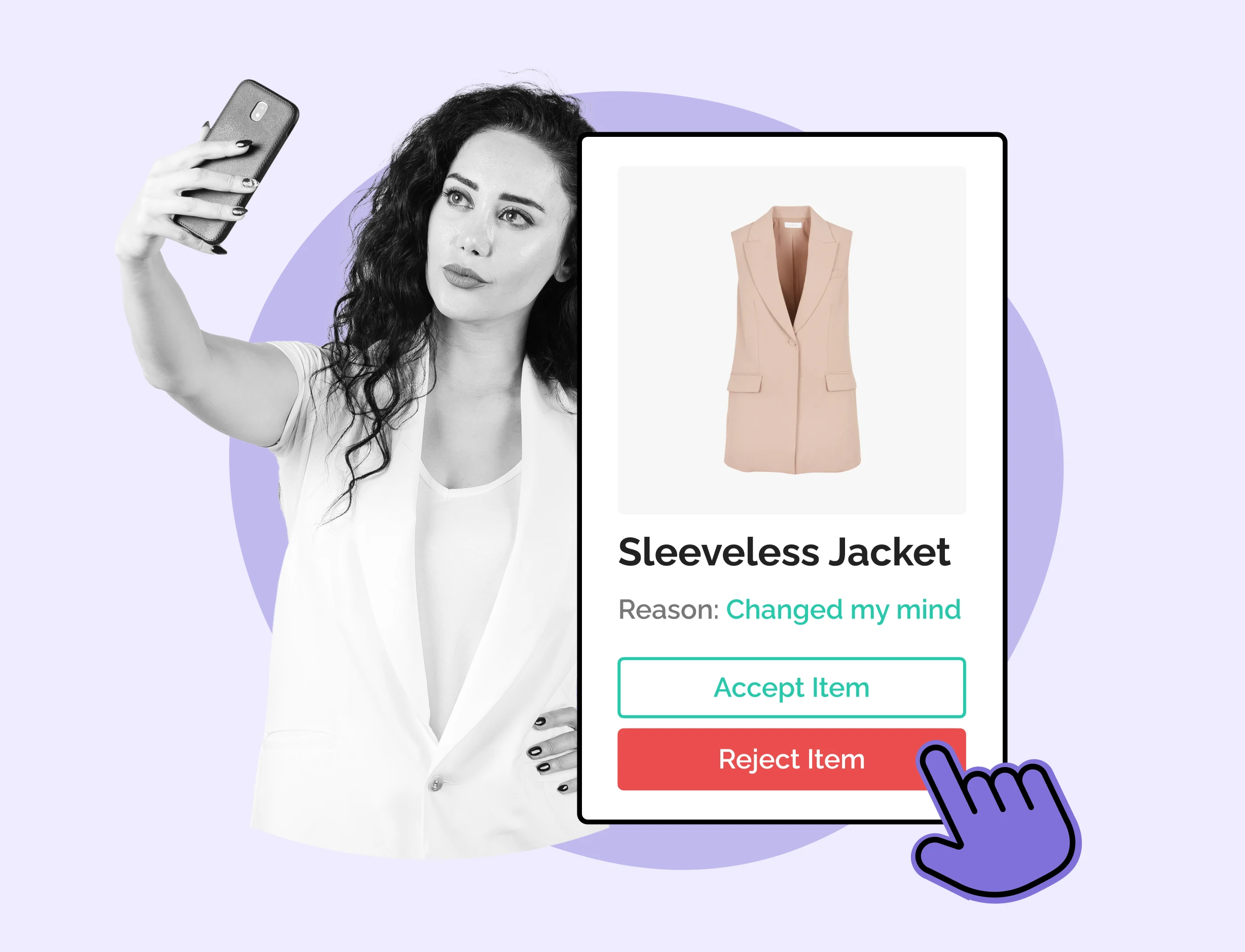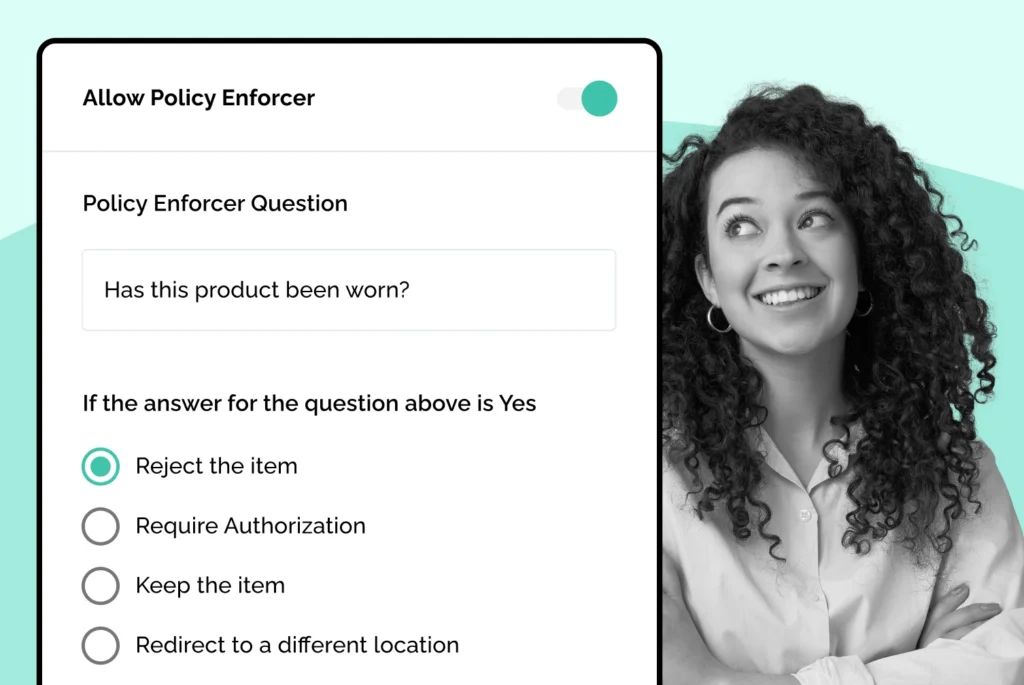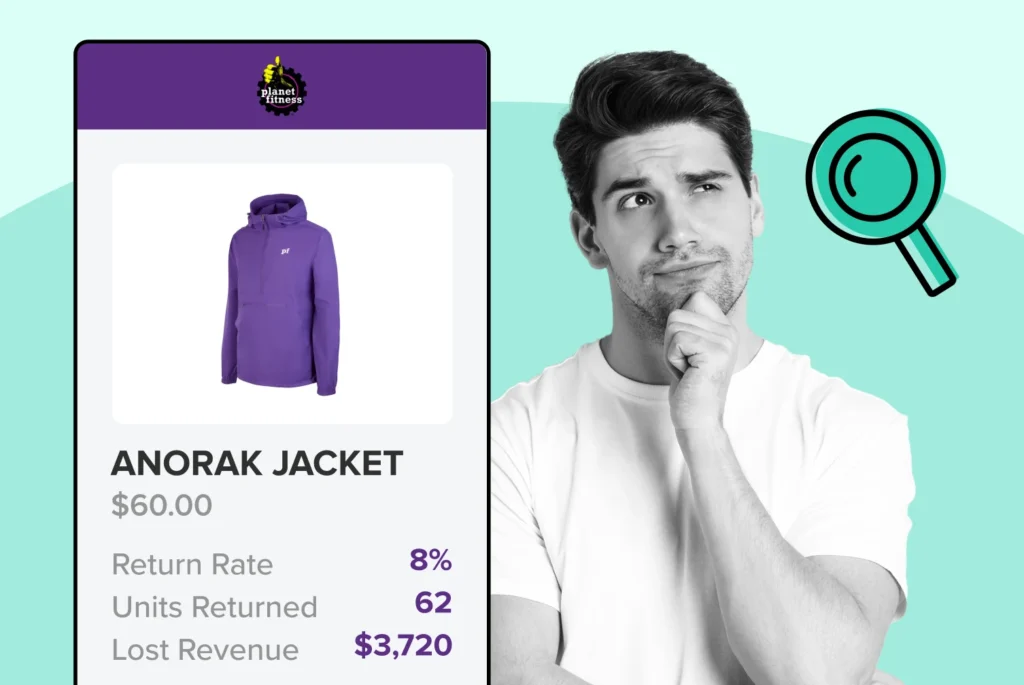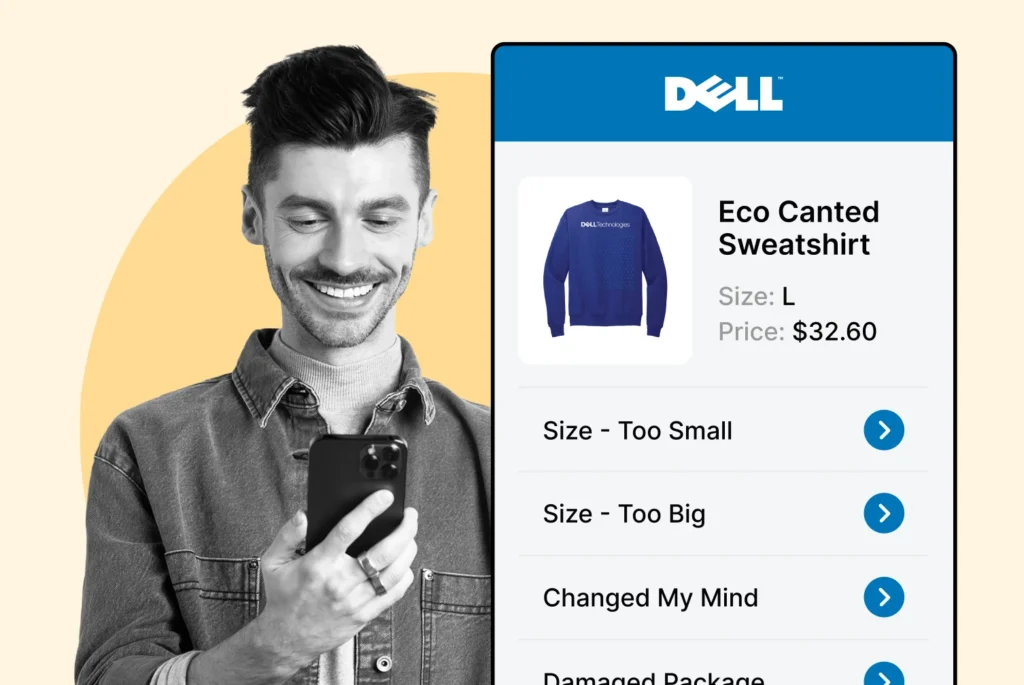
Top Strategies for Preventing Ecommerce Retail Return Fraud
Explore crucial data that will directly inform your strategy and operations: return rate, average return value, and customer refund patterns!
Shipping, Tracking & Notifications
Boost customer experience and reduce support tickets
Realtime order and shipment tracking
Proactive order and shipping notifications
AI-Enhanced Discounted Labels
Predictive pre-purchase estimated delivery dates
Self-Serivce branded order tracking
Effortless experience delivered
Identify and Resolve Order Issues
Realtime order and shipment tracking
Make returns profitable and delight customers
Flexibility to define any return destinations & conditions
Simplify returns for your customers and team
Incentivize exchanges over returns
Returns management made easy for your team
Returns management made easy for your team
Easy claims and smart upsells
Understand why your customers are returning
In-Store & Curbside Pickup
Unify the online and the in-store experience
Hassle-free pickup experience for customers
In-Store dashboard to keep operations streamlined
In-Store and Online orders unified
Drive foot-traffic to your stores
Shipping, Tracking & Notifications
Boost customer experience and reduce support tickets
Realtime order and shipment tracking
Proactive order and shipping notifications
AI-Enhanced Discounted Labels
Predictive pre-purchase estimated delivery dates
Self-Serivce branded order tracking
Effortless experience delivered
Identify and Resolve Order Issues
Realtime order and shipment tracking
Make returns profitable and delight customers
Flexibility to define any return destinations & conditions
Simplify returns for your customers and team
Incentivize exchanges over returns
Returns management made easy for your team
Returns management made easy for your team
Understand why your customers are returning
In-Store & Curbside Pickup
Unify the online and the in-store experience
Hassle-free pickup experience for customers
In-Store Dashboard to keep operations streamlined
In-Store and Online orders unified
Drive foot-traffic to your stores
Boost customer experience and reduce support tickets
Realtime order and shipment tracking
Proactive order and shipping notifications
AI-Enhanced Discounted Labels
Predictive pre-purchase estimated delivery dates
Self-Serivce branded order tracking
Effortless experience delivered
Make returns profitable and delight customers
Flexibility to define any return destinations & conditions
Simplify returns for your customers and team
Incentivize exchanges over returns
Returns management made easy for your team
Equip your team for precise return checks.
Easy claims and smart upsells
Understand why your customers are returning
Unify the online and the in-store experience
Hassle-free pickup experience for customers
In-Store Dashboard to keep operations streamlined
In-Store and Online orders unified
Drive foot-traffic to your stores
Find the answer to all your questions
Take a step by step trip through our functionality to see how we can improve your ecommerce processes.
Explore the most comon questions about WeSupply
Calculate the ROI that WeSupply can bring you
Read actionable articles on how to optimize your post-purchase experience and decrease support tickets
Get inspired by stories of how our customers implemented an effortless post-purchase experience
Wondering if WeSupply is a good fit for you? Read through our use cases to see how we can help you increase conversion & improve CX!
A Deep Dive into Top Companies' Order Tracking & Returns Strategy
Find the answer to all your questions
Explore the most comon questions about WeSupply
Calculate the ROI that WeSupply can bring you
Request a no strings attached review of your current shopping experience and missed conversion opportunities
Take a step by step trip through our functionality to see how we can improve your ecommerce processes.
Read actionable articles on how to optimize your post-purchase experience and decrease support tickets
Get inspired by stories of how our customers implemented an effortless post-purchase experience
A Deep Dive into Top Companies' Order Tracking & Returns Strategy
Wondering if WeSupply is a good fit for you? Read through our use cases to see how we can help you increase conversion & improve CX!

Are customers returning worn merchandise and impacting your bottom line? Learn how to prevent wardrobing return fraud with our five tailored eCommerce strategies to safeguard your retail business.
Wardrobing return fraud, where customers buy, use, and then return items as new, significantly impacts retailers financially by causing lost sales, increased processing costs, and markdowns on fraudulently returned items.
Combating wardrobing in e-commerce requires strategic measures such as clear return policies, thorough inspections, use of specialized anti-wardrobing tags, and offering store credit instead of cash refunds to deter fraudulent behavior.
Advancements in technology, like the implementation of digital tools and predictive models, are essential for monitoring, managing, and preventing wardrobing and other types of return fraud, ensuring retailers can stay ahead of evolving fraudulent practices.
WeSupply combats wardrobing return fraud through strict pre-built return policies and automated returns management. By leveraging a branded returns portal and store credit incentives, WeSupply ensures efficient handling of returns, fraud detection, and enhanced customer satisfaction. Get started with WeSupply to protect your business and improve returns management.
It’s estimated that around 10.7% of returned online purchases are fraudulent, with fashion retailers being hit the hardest by returns fraud. A considerable part of this fraud is wardrobing, where customers buy items, use them, and then return them as new. This crime is not victimless. It is damaging retailers financially and hurting their operations.
As a retailer, one may wonder how to identify wardrobing, understand its implications, and protect their business from this growing menace. The following sections will shed some light on these aspects.
Wardrobing, as a type of return fraud, is an abuse of lenient return policies. Customers buy items such as clothing, wear them (often with tags hidden), and then return them for a full refund. E-commerce has made wardrobing more accessible due to the anonymity of online shopping and return processes.
While this may seem like a clever loophole to some, it’s a significant problem for retailers. Not only does this result in financial losses from reduced profits and markdowns, but it also causes additional costs for processing, restocking, and evaluating resell-ability of fraudulently returned items, leading to lost sales.
From the surface, the economic impact of wardrobing on retailers might seem limited to refunds. But dig deeper, and there’s more to the story. Increased processing and labor costs, lost revenue from returned used inventory, and additional capital required to replace merchandise, all add up, causing a significant dent in a retailer’s financial health.
The anonymity of online returns has emboldened consumers to return worn items without having to explain, thus increasing the incidence of wardrobing in the eCommerce sector. Handling these fraudulent returns means higher labor costs and complex restocking procedures leading to inventory management issues. If that wasn’t enough, there’s an environmental cost too, with returned merchandise ending up in landfills.
While it’s easy to point fingers at ‘unethical customers’, the reality is more complex. It’s not just about people wanting to cheat the system. There are various reasons why customers resort to wardrobing, ranging from financial constraints to social pressures.
Even social media influencers often engage in wardrobing to create content for their online image, returning the items once they have served their purpose. In the following sections, we’ll explore the demographics and motivations that fuel wardrobing.
The pressure to maintain a certain image or lifestyle, especially prevalent among influencers, can motivate wardrobing behaviors. Clothing choices are essential in shaping first impressions, which includes inferences about the wearer’s:
social categories
cognitive states
status
aesthetic tastes
However, the complexity, cultural dependence, and variability of clothing’s psychological meaning have made it a challenging subject for research aimed at uncovering psychological universals. Despite these challenges, it’s clear that wardrobing is not merely a financial issue but also a psychological and social one.
Economic circumstances also play a significant role in wardrobing fraud. Consumers under financial strain may exhibit unethical behavior to save money. The trend of posting daily outfits on social media platforms like Instagram encourages people to engage in wardrobing.
Moreover, the desire to keep up with fashion trends and avoid outfit repetition can motivate people to engage in wardrobing. This shows that wardrobing is not just an individual’s problem but a societal one, influenced by broader economic and social trends.
Wardrobing poses not just economic challenges but also legal and ethical dilemmas. It makes up approximately 70% of all fraudulent returns in the retail industry, with an annual cost of $23.2 billion. But the impact goes beyond financial losses.
Ethical issues in eCommerce returns involve environmental impact, fairness of return policies, and employee welfare. The subsequent sections will thoroughly examine these aspects.
Wardrobing is often perceived by consumers as a victimless crime and difficult to legally pursue, creating a false reality. It breaches merchant policies and raises ethical concerns. While proving a ‘misrepresentation of a material fact’ by someone who knows or believes it to be false is often hard, legal cases of wardrobing often revolve around this concept.
However, the primary response to wardrobing is not usually legal action but refusal of a refund if the store suspects an item has been worn. This highlights the complexities of tackling wardrobing from a legal perspective.
While tackling wardrobing, it’s crucial to balance consumer rights with retailer protections. Measures like anti-wardrobing tags can prevent wardrobing while also respecting consumer rights.
Retailers also need to establish clear return policies to deter wardrobing practices. However, these measures should not compromise the consumer’s right to return items. This balance is crucial in maintaining not just legal compliance but also customer trust and loyalty.
So, how can retailers combat wardrobing? A strategic approach should involve a combination of:
Clear return policies
Thorough inspections
Specialized tags to identify wear
Providing store credit as a refund option
These strategies not only make wardrobing less convenient but also minimize its financial impacts. In the following sections, we will explore these strategies in detail.
The first line of defense against wardrobing is a clear and strict return policy. This policy should detail:
The types of returns accepted
Items eligible for return
Any fees such as restocking or return shipping
The time frame for initiating returns
The expected timeline for processing the return.
Prominent display of return policies on:
Websites
Invoices
Receipts
Product packaging
helps ensure customers are clearly aware of the terms and conditions governing returns. Not only does this set clear expectations but also deters potential fraudsters.
WeSupply’s Pre-built Return Policies offer a strategic framework to combat wardrobing by establishing clear and strict return policies. Key features include:
Specific SKU Restrictions: Improves inventory control by designating certain SKUs as non-returnable, aligning product strategy with return policies.
No Returns on Personalized Products: Reduces losses by prohibiting returns on personalized items, effectively balancing customization with return policies.
Sale Items Excluded from Returns: Implements a policy where sale items are non-returnable, balancing profitability with customer expectations.
With these measures in place, WeSupply’s Pre-built Return Policies empower businesses to enhance inventory management, maintain product quality, and protect profitability. Book a demo today to see how these policies can revolutionize your return management strategy!
Create custom return policies
Book a quick call with our experts to see how WeSupply can help you take control of returns by creating custom policies to handle them all easily. You get to decide how you want to handle final sale items, return window lengths, return request approvals, and more.
A meticulous inspection of returned items is critical in identifying and preventing wardrobing, as well as addressing buyer’s remorse. Retailers should look for signs of wear, tampering, or stolen or counterfeit items before issuing refunds.
This, however, means higher labor costs and complex restocking procedures leading to inventory management issues. But these costs are a small price to pay compared to the financial losses from wardrobing.
WeSupply’s Automated Returns Management system enhances the strategic framework to combat wardrobing by emphasizing a robust inspection process in reverse logistics. By enabling customers to upload images and describe issues directly on the branded returns page, the system streamlines communication and captures essential product condition details. This functionality not only eliminates the need for lengthy email exchanges but also enriches the quality control process. Each return is meticulously inspected based on predefined quality criteria, and warehouse staff can annotate specific observations, ensuring that only resalable items are restocked. This comprehensive approach to handling returns significantly improves inventory management and customer satisfaction.
The use of return portals can assist in verifying the state of returned items and reducing the incidence of wardrobing. These portals can be enhanced with features such as image uploads to allow retailers to verify the condition of returned items and more effectively decide on the approval or denial of returns.
Moreover, online return portals can:
Automatically verify purchases before a return is created, reducing the risk of fraudulent returns
Provide an additional layer of security
Improve the customer return experience.
WeSupply empowers businesses to effectively combat wardrobing through its branded returns portal, which not only enhances customer loyalty but also bolsters fraud detection. By providing a fully customizable, user-friendly interface, businesses can offer a seamless, branded post-purchase experience with intuitive return rules that help identify suspicious return patterns. This tailored approach ensures better fraud detection while maintaining a positive customer experience, aligning brand identity with strategic anti-fraud measures.
Offering store credit instead of cash refunds can be an effective strategy to discourage wardrobing. It ensures that customers continue to engage with the retailer for future purchases.
Moreover, customers choosing store credit over cash refunds have several benefits for the retailer:
They are more likely to make additional purchases, thereby generating additional revenue.
This approach deters wardrobing.
It encourages customer loyalty.
WeSupply’s strategic approach to combating wardrobing leverages store credit to deter return fraud effectively. By incentivizing exchanges with instant store credit, customers are encouraged to reinvest in the product catalog, boosting sales and increasing average order value. The option to refund via store credit, gift card, or coupon code further fosters customer loyalty, reducing fraudulent returns while strengthening customer trust and encouraging repeat purchases.
The battle against wardrobing cannot be won without technological interventions. From anti-wardrobing tags to digital tools for managing returns, technology plays a crucial role in preventing wardrobing and other types of return fraud.
The following sections will delve into these technological interventions and their respective impacts.
Anti-wardrobing tags, like the 360 ID Tag, offer the following benefits:
Add a layer of security against counterfeit product switches and price tag alterations
Designed to be practical and affordable
Can be applied without damaging the merchandise.
Anti-wardrobing tags are designed to discourage return fraud by being difficult to remove and reattach without evidence of tampering. This not only protects the retailer but also sets a clear deterrent for potential fraudsters, thanks to the tamper evident security seal.
Digital tools can enhance the management of returns by:
Providing real-time tracking of inventory
Connecting upstream manufacturing with downstream sales for demand forecasting
Reducing errors through automation and accurate recording.
Moreover, businesses can use automated returns authorization systems to:
Validate the eligibility of returns through technology
Minimize the need for manual processing
Improve customer satisfaction
Streamline the return process
Detect and prevent fraudulent returns
WeSupply’s Automated Returns Management system leverages advanced digital tools to enhance technological interventions and anti-wardrobing measures. Key features include:
Streamline the Returns Process: Automatically apply specific restocking fees, return policies, and detect fraud, reducing customer emails and streamlining refunds.
Reduce Returns Fraud Rate: Intelligent fraud prevention detects policy abuse, automatically blocking flagged customers.
Reduce Human Errors: Automate returnable product validation, restocking fee calculations, and return label generation to minimize errors.
Inspect Returns and Manage Inventory Better: Maintain quality control with thorough inspections and restocks.
Improve Efficiency and Communication: An activity log of RMAs fosters collaboration between support and warehouse teams, ensuring efficient and accurate return management.
While combating wardrobing, it’s crucial not to compromise the customer return experience. A positive return experience not only builds customer loyalty but also encourages ethical shopping habits, reducing wardrobing occurrences.
To achieve this, retailers need to communicate return policies clearly, monitor customer returns, and set reasonable time limits and conditions for returns. The subsequent sections will thoroughly examine these aspects.
Monitoring customer returns and managing suspicious activities is key in preventing wardrobing. Retailers should track customer behaviors and flag suspicious activities, such as identifying serial returners and banning them if necessary.
Digital tools can also help in detecting return fraud and preventing other forms of return fraud. For instance, e-commerce sites can monitor inconsistencies in order data, such as mismatched zip codes and cities, or the IP address of the shopper not matching their email address.
WeSupply’s Returns Analytics empowers businesses to enhance the customer return experience by offering deep insights into return patterns. With detailed analytics, companies can identify the most frequently returned products and understand the reasons behind these returns, allowing them to address issues proactively. By pinpointing serial returners and monitoring suspicious activities, WeSupply helps reduce the return rate through actionable insights, while comprehensive data available in BigQuery ensures a data-driven approach to optimizing return policies and customer satisfaction.
Setting time limits and specific conditions for returns can reduce the occurrence of wardrobing by making the practice less convenient for customers. Retailers can set a time limit for returns and specify the condition that returned products need to be in, such as unused and in original packaging, to qualify for a return.
However, it’s critical that these limits and conditions are communicated clearly and prominently to customers, to avoid any confusion or misunderstanding.
WeSupply’s Pre-built Return Policies streamline the customer return experience by providing clear guidelines on time limits and conditions for returns. These predefined rules offer transparency and consistency, ensuring customers understand the return process while helping businesses enforce fair and strategic policies. This clarity not only enhances customer satisfaction but also reduces the potential for abuse, ultimately fostering trust and efficiency in the return experience.
As e-commerce continues to grow, so does the threat of wardrobing and other types of return fraud. Retailers need to be proactive in combating fraud, moving away from reactive strategies to more customer-centric approaches that are integrated and continuously evolving.
Predictive analytics is increasingly playing a significant role in combating eCommerce fraud. Organizations are leveraging it to stay ahead of fraudsters and protect their operations.
Predictive models, using artificial intelligence and machine learning, are essential for identifying and reacting to new types of eCommerce fraud. They help mitigate the financial impact of fraud by enabling businesses to take action early and maintain customer trust.
However, these models need to be continually updated to keep pace with evolving fraud patterns. As fraudsters develop new methods to circumvent business systems, businesses need to stay one step ahead.
Adapting to changing consumer behaviors and technological advances is also crucial for effective return fraud prevention. Retailers are introducing advanced technologies, such as artificial intelligence and machine learning, to bridge the gap between online and in-store shopping experiences and better understand customer needs.
Moreover, with consumers prioritizing convenience and eco-friendliness, retailers are offering more diverse, convenient, and environmentally friendly products. This not only meets customer expectations but also builds trust, reducing the likelihood of fraudulent behaviors like wardrobing. According to the National Retail Federation, this trend is becoming increasingly important in the industry.
Building resilience against wardrobing in eCommerce involves a combination of:
Clear return policies
Stringent inspections
Advanced technology
A keen understanding of customer behaviors
Wardrobing extends beyond being a financial problem for retailers, encompassing complexity in psychology, economics, and technology.
The future of eCommerce fraud prevention hinges on predictive models, the evolution of consumer behaviors, and advancements in technology. In order to safeguard their businesses and customers, retailers must remain agile, continually adapt their strategies, and stay a step ahead of fraudsters.
Moving forward, retailers need to continuously adapt and enhance their fraud prevention measures to combat those who commit return fraud. This includes using return portals that collect information about return reasons, request photo evidence, and set eligibility conditions.
Moreover, vigilance is key. Retailers need to conduct thorough inspections of returned items and monitor customer records for abnormal patterns. This proactive approach to combating wardrobing not only protects their business but also builds customer trust and loyalty.
In conclusion, wardrobing return fraud is a growing menace affecting the eCommerce industry. It’s a complex issue, involving legal, ethical, and psychological aspects. Retailers need to adopt a mix of clear return policies, stringent inspections, specialized tags, and store credit as a refund option to deter wardrobing. Technological advances and predictive models can help stay ahead of fraudsters. However, in all these measures, it’s crucial to balance consumer rights with retailer protections and enhance the customer return experience to encourage ethical shopping habits.
WeSupply offers comprehensive solutions to prevent wardrobing return fraud through its robust suite of return management tools. With pre-built return policies that enforce strict conditions on used, personalized, and sale items, businesses can maintain quality control and protect profitability. Automated Returns Management improves reverse logistics by enabling thorough inspections, streamlining communications, and setting predefined quality criteria for returns. A branded returns portal enhances customer loyalty while identifying suspicious return patterns, and the use of store credit deters fraudulent activity by encouraging reinvestment in the product catalog. With digital tools for monitoring returns and actionable insights from Returns Analytics, WeSupply equips businesses with the framework to handle returns efficiently and maintain customer satisfaction. Get started with WeSupply to secure your business against return fraud while optimizing the customer return experience.
Speed up returns process
Book a quick call with our experts to see how WeSupply’s self-service returns makes it super easy for your customers to return anything, anytime – without needing to submit customer support tickets or call in!
Wardrobing return fraud occurs when customers buy clothing, wear it, and then return it for a refund, taking advantage of generous return policies. It’s a form of return fraud that exploits lenient return policies.
Wardrobing negatively impacts retailers by leading to financial losses through reduced profits, increased markdowns, and additional processing and restocking costs.
To combat wardrobing, retailers should implement clear return policies, conduct thorough inspections of returned items, use anti-wardrobing tags, and offer store credit instead of cash refunds. This helps to deter customers from purchasing items for short-term use and returning them after.
WeSupply combats wardrobing return fraud by implementing strict pre-built return policies that establish clear guidelines on returns for used, personalized, and sale items. This helps maintain quality control and profitability by setting conditions that prevent the misuse of return policies.
The Automated Returns Management system streamlines returns through robust inspections, efficient communication, and predefined quality criteria. This process identifies suspicious returns and enhances reverse logistics, reducing the chance of fraudulent activities.
Returns Analytics provides insights into return patterns, helping businesses identify frequently returned products and reasons behind returns. This data-driven approach pinpoints serial returners, monitors suspicious activities, and helps businesses proactively adjust return policies to prevent fraud.
Yes, WeSupply does have an official Shopify App. You can download and begin to integrate it with your Shopify store.
Yes, WeSupply has an official extension for Magento. The WeSupply x Magento integration allows for automating order tracking experiences, reducing customer inquiries, automating shipping email and SMS notifications, and providing a fully branded order tracking experience
Yes, WeSupply has an official BigCommerce App. You can integrate WeSupply with your BigCommerce store to improve your post-purchase customer experience.

Learn How To Create Successful Post Purchase Email Campaigns
Build an effective post-purchase email flow that helps you increase customer satisfaction and drive revenue growth!
Consumers seek the best deals on:

Explore crucial data that will directly inform your strategy and operations: return rate, average return value, and customer refund patterns!

Discover 9 proven steps to combat return fraud & improve returns management. Prevent abuse, protect profits, and create a trustworthy policy!

Targeted actions to help you minimize the risk of fraudulent returns and keep your revenue intact without compromising customer experience!

Discern between fraudulent and legitimate returns & enforce preventive measures effectively: a realistic approach to preventing return fraud.

Explore crucial data that will directly inform your strategy and operations: return rate, average return value, and customer refund patterns!

Let’s dive into innovative approaches that equip you with actionable insights on harnessing the full potential of returns data!

How you can leverage the different return metrics to fine-tune your business strategy and drive sustainable growth!

Concrete strategies for preventing ecommerce return fraud: from strengthening your return policy to leveraging technology and analytics!

Practical strategies and real-world applications to turn your returns into a powerful operational efficiency and customer satisfaction tool!